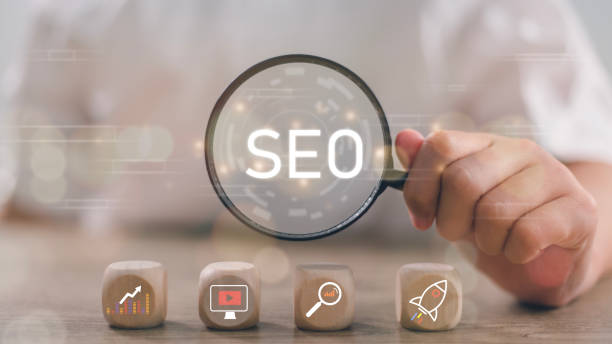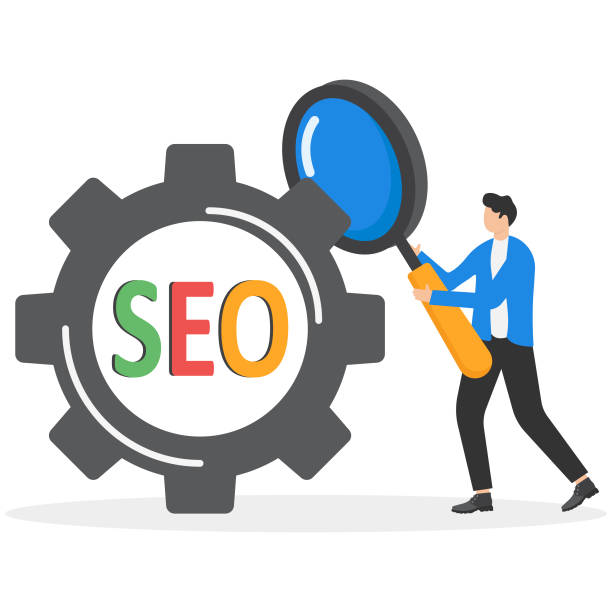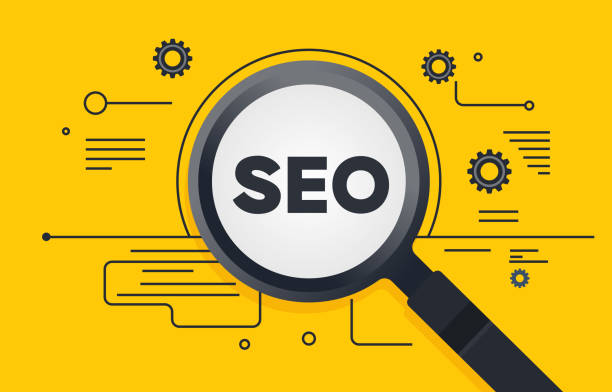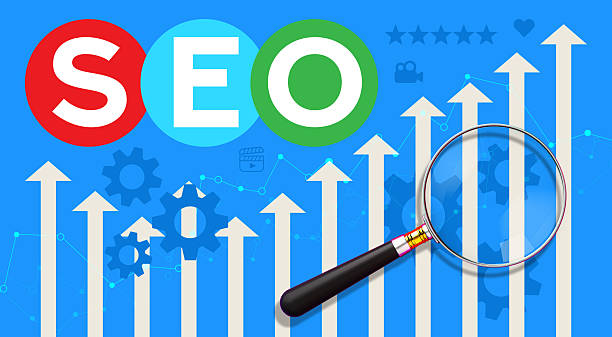مقدمهای بر دنیای سئو و بهینهسازی موتورهای جستجو

در عصر حاضر که بازاریابی دیجیتال حرف اول را میزند و رقابت برای جلب توجه کاربران بیش از پیش شده است، سئو یا بهینهسازی موتورهای جستجو به یکی از حیاتیترین عناصر موفقیت آنلاین برای هر کسبوکار و وبسایتی تبدیل شده است.
#سئو فراتر از یک تکنیک ساده، مجموعهای گسترده از دانشها، استراتژیها و بهترین شیوههاست که به منظور افزایش دیدهشدن وبسایت شما در نتایج ارگانیک موتورهای جستجو، بهویژه گوگل، طراحی شده است.
هدف اصلی از این بهینهسازی، ارتقاء رتبه صفحات شماست تا در هنگام جستجوی کلمات کلیدی مرتبط با کسبوکار یا محتوایتان، در بالاترین جایگاه ممکن نمایش داده شوید.
این تنها به معنای افزایش ترافیک ورودی نیست، بلکه به معنای جذب ترافیک هدفمند و باکیفیت است؛ بازدیدکنندگانی که به طور فعال به دنبال محصولات، خدمات یا اطلاعاتی هستند که شما ارائه میدهید، و در نتیجه، احتمال تبدیل شدن آنها به مشتری یا مخاطب وفادار به طرز چشمگیری افزایش مییابد.
اهمیت سئو در این حقیقت نهفته است که اغلب کاربران اینترنت از صفحه اول نتایج جستجو فراتر نمیروند و عمده کلیکها بر روی سه نتیجه اول صورت میگیرد.
بنابراین، عدم حضور در این موقعیتهای برتر به معنای از دست دادن بخش عظیمی از فرصتهای بازاریابی و فروش است.
از جنبه توضیحی و بنیادی، سئو شامل دو رکن اصلی است: سئو داخلی (On-Page SEO) که بهینهسازی عناصر درون وبسایت مانند محتوا و ساختار آن را شامل میشود، و سئو خارجی (Off-Page SEO) که به فعالیتهای خارج از سایت مانند لینکسازی و اعتبارسازی میپردازد.
هر یک از این بخشها، دارای وظایف و تکنیکهای خاص خود هستند که به صورت مکمل یکدیگر عمل میکنند.
فرآیند سئو مستلزم درک عمیق از نحوه کار موتورهای جستجو، تحلیل دقیق کلمات کلیدی مورد استفاده توسط مخاطبان، تولید محتوای ارزشمند و منحصر به فرد، و بهینهسازی فنی مداوم وبسایت است.
علاوه بر این، توجه به تجربه کاربری (UX) و سازگاری با موبایل از اصول جدانشدنی سئو مدرن به شمار میروند.
در نهایت، هدف غایی سئو، افزایش قابلیت دیده شدن ارگانیک، بهبود مداوم تجربه کاربری، و در نتیجه، رشد پایدار و موفقیتآمیز کسبوکار آنلاین شما در محیط رقابتی دیجیتال است.
آیا وبسایت فعلی شما بازدیدکنندگان را به مشتری تبدیل میکند یا آنها را فراری میدهد؟ با طراحی سایت شرکتی حرفهای توسط رساوب، این مشکل را برای همیشه حل کنید!
✅ ایجاد اعتبار و برندسازی قدرتمند
✅ جذب مشتریان هدف و افزایش فروش
⚡ همین حالا مشاوره رایگان بگیرید!
سئو داخلی (On-Page SEO) سنگ بنای دیده شدن

سئو داخلی به مجموعهای از تکنیکها و اقداماتی گفته میشود که مستقیماً در داخل وبسایت شما و بر روی آن انجام میشود تا رتبه آن در نتایج موتورهای جستجو بهبود یابد.
این بخش از بهینهسازی وبسایت، بر روی عناصری تمرکز دارد که شما کنترل کاملی بر آنها دارید.
اولین گام در سئو داخلی، تحقیق و انتخاب دقیق کلمات کلیدی است؛ شناسایی عباراتی که کاربران هدف شما برای یافتن محتوای مرتبط با کسبوکار شما در گوگل جستجو میکنند.
پس از آن، این کلمات کلیدی باید به صورت استراتژیک و طبیعی در تمام بخشهای مهم صفحه، از جمله عنوان صفحه (Title Tag)، توضیحات متا (Meta Description) که در نتایج جستجو نمایش داده میشود، سرفصلهای محتوا (H1, H2, H3 و…) و متن اصلی محتوا قرار گیرند.
عنوان صفحات باید جذاب و حاوی کلمه کلیدی اصلی باشد، در حالی که توضیحات متا باید کاربران را به کلیک ترغیب کند.
از جنبه تخصصی، کیفیت محتوا از اهمیت بالایی برخوردار است؛ محتوای شما باید یونیک، جامع، دقیق، و برای کاربران به شدت جذاب و مفید باشد.
گوگل به محتوایی که نیازهای کاربران را برآورده سازد، ارزش بالایی میدهد.
بهینهسازی تصاویر با استفاده از Alt Text مناسب و حجم بهینه، بهبود ساختار URL ها برای خوانایی بیشتر و حاوی بودن کلمات کلیدی، و لینکسازی داخلی (Internal Linking) هوشمندانه از دیگر جنبههای مهم سئو داخلی هستند.
لینکسازی داخلی به موتورهای جستجو کمک میکند تا ساختار سایت شما را بهتر درک کنند، صفحات جدید را کشف نمایند و اعتبار صفحات را در سراسر سایت توزیع کنند.
همچنین، سرعت بارگذاری صفحه و تجربه کاربری (UX) مطلوب، سیگنالهای مثبت و حیاتی را به گوگل ارسال میکنند.
تمام این عوامل در کنار هم به گوگل نشان میدهند که صفحه شما چقدر مرتبط، معتبر و ارزشمند است، که در نتیجه به ارتقاء رتبه شما در نتایج جستجو و افزایش visibility کمک شایانی میکند.
تمرکز دقیق و مستمر بر این اصول پایهای سئو داخلی، زمینه را برای موفقیتهای بزرگتر در دنیای رقابتی آنلاین فراهم میآورد.
سئو خارجی (Off-Page SEO) و اهمیت بکلینکها

سئو خارجی به تمام اقداماتی اطلاق میشود که خارج از وبسایت شما انجام میشوند تا اعتبار (Authority) و شهرت (Reputation) آن را در نظر موتورهای جستجو افزایش دهند.
این فعالیتها عمدتاً بر روی جذب سیگنالهای مثبت از منابع بیرونی تمرکز دارند.
مهمترین و تاثیرگذارترین فاکتور در سئو خارجی، بدون شک بکلینکها هستند.
بکلینکها، لینکهایی از سایر وبسایتها به سایت شما هستند که به منزله «رای اعتماد» یا «ارجاع» از سوی دیگران به محتوا یا کسبوکار شما تلقی میشوند.
هرچه کیفیت، اعتبار، و ارتباط موضوعی سایتهایی که به شما لینک میدهند بالاتر باشد، ارزش آن بکلینک بیشتر است و تاثیر مثبت آن بر سئو سایت شما نیز فزونتر خواهد بود.
این بخش از بهینهسازی برای موتورهای جستجو نیازمند استراتژیهای راهنمایی دقیق برای لینکسازی است، از جمله تولید محتوای بسیار باکیفیت و ارزشمند که به طور طبیعی مورد ارجاع قرار گیرد، برقراری ارتباط با وبلاگنویسان و اینفلوئنسرهای معتبر در صنعت خود، و استفاده از تکنیکهای Guest Posting (نوشتن مقاله مهمان برای سایتهای دیگر).
علاوه بر بکلینکها، سیگنالهای اجتماعی نیز نقش مهمی ایفا میکنند؛ اشتراکگذاری محتوای شما در شبکههای اجتماعی محبوب، هرچند مستقیماً روی رتبه تأثیر نگذارد، اما میتواند به افزایش دیده شدن، جذب مخاطبان جدید و در نتیجه کسب بکلینکهای طبیعی (Organic Backlinks) کمک کند.
فعالیت در فرومها، انجمنهای آنلاین و گروههای مرتبط با صنعت، و همچنین ذکر نام برند شما در وبسایتهای مختلف (Brand Mentions)، حتی بدون لینک مستقیم، نیز به افزایش اعتبار و آگاهی از برند شما کمک میکند.
این فرآیندها به موتورهای جستجو نشان میدهند که وبسایت شما یک منبع معتبر، محبوب و قابل اعتماد در حوزه خود است، که در نهایت به بهبود رتبه سئو شما در نتایج جستجو و افزایش اقتدار دامنه (Domain Authority) منجر میشود.
توسعه استراتژی سئو خارجی یک فرآیند زمانبر اما بسیار پربازده در بلندمدت است.
| استراتژی بکلینکسازی | توضیحات مختصر | میزان تاثیر بر سئو |
|---|---|---|
| تولید محتوای ستون (Pillar Content) | ایجاد محتوای جامع و عمیق که به طور طبیعی توسط دیگران به عنوان مرجع به آن لینک داده شود. | بسیار بالا |
| لینکسازی مهمان (Guest Posting) | نوشتن مقالات با کیفیت برای وبلاگها و سایتهای معتبر در صنعت خود و قرار دادن لینک مرتبط به سایت. | متوسط تا بالا |
| بازسازی لینکهای شکسته (Broken Link Building) | یافتن لینکهای شکسته در سایتهای معتبر و پیشنهاد محتوای خود به جای آن. | متوسط |
| لینکسازی از دایرکتوریها و فهرستهای تجاری | ثبت سایت در دایرکتوریهای معتبر و تخصصی و فهرستهای محلی کسبوکار. | پایین تا متوسط |
| تحلیل رقبا و یافتن فرصتهای لینکسازی | بررسی بکلینکهای موفق رقبا و تلاش برای کسب لینک از همان منابع یا منابع مشابه. | بالا |
| اشتراکگذاری در شبکههای اجتماعی | ترویج محتوا در پلتفرمهای اجتماعی برای افزایش دیده شدن و جذب لینکهای طبیعی. | غیرمستقیم بالا |
سئو تکنیکال (Technical SEO) از سرعت سایت تا تجربه کاربری

سئو تکنیکال به بهینهسازی جنبههای فنی وبسایت میپردازد تا موتورهای جستجو بتوانند آن را راحتتر خزش (crawl) و ایندکس (index) کنند و تجربه کاربری بهتری را برای بازدیدکنندگان فراهم آورند.
این بخش از سئو حیاتی است زیرا حتی بهترین محتوا و قویترین بکلینکها نیز بدون یک پایه فنی قوی بیاثر خواهند بود.
یکی از مهمترین فاکتورها در سئو تکنیکال، سرعت بارگذاری صفحه (Page Speed) است.
کاربران و موتورهای جستجو هر دو به سایتهای سریعتر علاقهمند هستند؛ گوگل حتی سرعت را به عنوان یک فاکتور رتبهبندی مهم اعلام کرده است.
ابزارهایی مانند Google PageSpeed Insights و GTmetrix میتوانند به شناسایی مشکلات و ارائه راهکارهای بهبود سرعت کمک کنند، از جمله فشردهسازی تصاویر، بهینهسازی کدهای CSS و JavaScript، و استفاده از کش مرورگر.
ریسپانسیو بودن سایت برای موبایل نیز از اهمیت بالایی برخوردار است، زیرا بخش عظیمی از جستجوها امروزه از طریق دستگاههای موبایل انجام میشود و گوگل تاکید زیادی بر موبایل-فرست ایندکسینگ (Mobile-first indexing) دارد.
استفاده از پروتکل امن HTTPS (داشتن گواهی SSL) برای رمزنگاری دادهها، ساختار URL دوستانه با سئو (Short, Descriptive, Keyword-rich)، و ایجاد فایلهای نقشه سایت (Sitemap.xml) و فایل Robots.txt صحیح، از دیگر جنبههای کلیدی سئو تکنیکال هستند.
نقشه سایت به موتورهای جستجو کمک میکند تا تمامی صفحات مهم شما را بیابند، و Robots.txt خزشگرها را هدایت میکند که کدام بخشها را خزش کنند و کدام بخشها را نادیده بگیرند.
حذف خطاهای ۴۰۴ (صفحات یافت نشد)، ریدایرکتهای ۳۰۱ مناسب برای صفحات جابجا شده، و مدیریت Canonical Tags برای جلوگیری از محتوای تکراری، همگی به بهبود خزش و ایندکسینگ کمک میکنند.
این رویکرد تحلیلی، پایه و اساس یک وبسایت قدرتمند از دیدگاه موتورهای جستجو را تشکیل میدهد و به پایداری رتبههای سئو و ارائه یک تجربه کاربری بینقص کمک میکند.
رویای فروشگاه آنلاین پررونق رو دارید ولی نمیدونید از کجا شروع کنید؟
رساوب راهکار جامع طراحی سایت فروشگاهی شماست.
✅ طراحی جذاب و کاربرپسند
✅ افزایش فروش و درآمد⚡ دریافت مشاوره رایگان
تولید محتوای ارزشمند محور اصلی سئو مدرن

در دنیای سئو امروز، محتوا پادشاه است و بدون محتوای باکیفیت و ارزشمند، دستیابی به رتبههای بالا در نتایج جستجو تقریباً ناممکن است.
تولید محتوای مفید و جذاب نه تنها به جذب کاربران کمک میکند، بلکه به موتورهای جستجو نشان میدهد که وبسایت شما یک منبع معتبر، موثق و مفید در حوزه خود است.
انواع مختلفی از محتوا وجود دارد که هر یک میتوانند برای اهداف خاصی در استراتژی سئو شما به کار روند و تنوع در محتوا نیز خود یک فاکتور مثبت محسوب میشود.
محتوای آموزشی مانند مقالات “چگونه…”، راهنماهای گام به گام، یا آموزشهای ویدئویی، به کاربران کمک میکند تا مشکلی را حل کنند یا مهارت جدیدی را یاد بگیرند و به عنوان یک منبع دانشی شناخته شوند.
محتوای سوالبرانگیز، که به پرسشهای رایج و متداول کاربران در صنعت شما پاسخ میدهد یا دیدگاههای جدیدی را مطرح میکند، میتواند تعامل را افزایش داده و کاربران را به عمق بیشتری از سایت شما بکشاند.
محتوای خبری، که آخرین تحولات، آمار و رویدادهای صنعت را پوشش میدهد، به روز نگه داشتن سایت، جذب ترافیک جدید و نشان دادن پویایی شما کمک میکند.
برای جذابیت بیشتر و جلب طیف وسیعتری از مخاطبان، میتوان از محتوای سرگرمکننده مانند اینفوگرافیکهای تعاملی، ویدئوهای کوتاه جذاب، پادکستها، یا آزمونها و مسابقات استفاده کرد که قابلیت اشتراکگذاری بالایی دارند و میتوانند ویروسی شوند.
علاوه بر این، محتوای تحلیلی و تخصصی عمیق (مانند Case Studies، White Papers، یا گزارشهای تحقیقاتی) برای مخاطبان حرفهای و B2B مناسب است و میتواند اعتبار شما را در صنعت به شدت افزایش دهد.
یک استراتژی محتوا محور برای سئو باید بر درک دقیق قصد کاربر (User Intent) تمرکز کند و محتوایی را ارائه دهد که دقیقاً نیازهای او را برآورده سازد و حتی از انتظاراتش فراتر رود.
استفاده طبیعی و هوشمندانه از کلمات کلیدی مرتبط، ساختاردهی مناسب محتوا با سرفصلها و پاراگرافهای کوتاه برای خوانایی بهتر، و بهروزرسانی منظم محتوای قدیمی، همگی به تقویت جایگاه سئو وبسایت شما و جذب مخاطبان بیشتر کمک میکنند.
تحقیق کلمات کلیدی ابزار قدرتمند بازاریابی محتوایی

تحقیق کلمات کلیدی ستون فقرات و نقطه آغازین هر استراتژی موفق سئو است.
این فرآیند شامل یافتن، آنالیز و انتخاب کلمات و عباراتی است که مخاطبان هدف شما به احتمال زیاد در موتورهای جستجو تایپ میکنند تا محصولات، خدمات یا اطلاعاتی مشابه آنچه شما ارائه میدهید را پیدا کنند.
هدف از این تحقیق، شناسایی کلمات کلیدی با حجم جستجوی بالا، رقابتپذیری مناسب و مرتبطترین ارتباط با کسبوکار شماست که بتوانند ترافیک مرتبط و هدفمند را به وبسایت شما هدایت کنند.
به عنوان یک رویکرد تخصصی و ضروری، ابزارهای متعددی مانند Google Keyword Planner, Ahrefs, Semrush, Ubersuggest, و KWFinder برای این منظور وجود دارند که دادههای ارزشمندی در مورد حجم جستجو، میزان رقابت، کلمات کلیدی مرتبط و ایدههای محتوایی جدید ارائه میدهند.
علاوه بر کلمات کلیدی کوتاه (Short-tail Keywords) که معمولاً رقابت بالایی دارند، تمرکز بر کلمات کلیدی طولانی (Long-tail Keywords) نیز از اهمیت بالایی برخوردار است.
این کلمات معمولاً حجم جستجوی کمتری دارند اما قصد کاربر را دقیقتر نشان میدهند (مثلاً “بهترین روش حذف لکه چربی از فرش سفید” در مقابل “پاک کردن لکه”).
کلمات کلیدی طولانی معمولاً نرخ تبدیل بالاتری دارند زیرا کاربران در مراحل پایانی فرآیند خرید یا نیاز به اطلاعات بسیار خاصی هستند.
درک قصد کاربر (Search Intent) در پس هر کلمه کلیدی، بسیار مهم است؛ آیا کاربر به دنبال اطلاعات است (Informational Intent)، قصد خرید دارد (Transactional Intent)، به دنبال یک وبسایت خاص است (Navigational Intent) یا به دنبال کشف و بررسی است (Commercial Investigation)? تطبیق محتوای شما با این قصد جستجو، شانس شما را برای رتبهبندی بالاتر در سئو و جلب رضایت کاربر افزایش میدهد.
این فرآیند تحقیق کلمات کلیدی یک فعالیت مداوم است و باید به طور منظم برای یافتن فرصتهای جدید، سازگاری با تغییرات در رفتار جستجوی کاربران و تحلیل رقبا، بهروز شود.
یک تحقیق کلمات کلیدی دقیق و جامع، مسیری روشن برای تولید محتوای هدفمند و بهینهسازی موثر برای سئو فراهم میکند و به کسبوکارها کمک میکند تا در فضای دیجیتال به درستی دیده شوند.
اندازهگیری موفقیت سئو و آنالیز دادهها

پس از اجرای استراتژیهای سئو، اندازهگیری، رصد و آنالیز دادهها برای ارزیابی عملکرد، شناسایی فرصتهای بهبود و اثبات بازگشت سرمایه (ROI) بسیار حیاتی است.
این بخش از بهینهسازی موتورهای جستجو نیازمند یک نگاه تحلیلی و استفاده از ابزارهای مناسب است تا بتوانید عملکرد وبسایت خود را در نتایج جستجو ارزیابی کنید.
مهمترین و پرکاربردترین ابزارها در این زمینه گوگل آنالیتیکس (Google Analytics) و گوگل سرچ کنسول (Google Search Console) هستند.
گوگل آنالیتیکس اطلاعاتی جامع و دقیق در مورد ترافیک وبسایت شما (تعداد بازدیدکنندگان، زمان ماندگاری در سایت، نرخ پرش، صفحات پربازدید، و منبع ترافیک)، رفتار کاربران و نرخ تبدیل (Conversion Rate) ارائه میدهد.
در مقابل، سرچ کنسول نیز دادههایی حیاتی در مورد عملکرد سایت شما در نتایج جستجو (مانند تعداد کلیکها، نمایشها، میانگین رتبه کلمات کلیدی، و پرسوجوها)، خطاهای خزش و مشکلات فنی سایت را فراهم میکند که مستقیماً به سئو مربوط میشوند.
معیارهای کلیدی عملکرد (KPIs) در سئو شامل رتبهبندی کلمات کلیدی، ترافیک ارگانیک، نرخ پرش، زمان ماندگاری در سایت (Dwell Time)، نرخ کلیک (CTR) و نرخ تبدیل هستند.
رصد مداوم این معیارها به شما کمک میکند تا اثربخشی تلاشهای سئو خود را بسنجید، تشخیص دهید کدام استراتژیها موفق بودهاند و کدام نیاز به بهینهسازی یا تغییر دارند.
مثلاً، اگر ترافیک ارگانیک شما افزایش یافته اما نرخ تبدیل پایین است، ممکن است محتوای شما به خوبی با قصد کاربر مطابقت نداشته باشد یا تجربه کاربری (UX) نیاز به بهبود داشته باشد.
با تحلیل دقیق این دادهها، میتوانید تصمیمات مبتنی بر داده برای بهبود مستمر استراتژیهای سئو خود اتخاذ کنید و به اهداف کسبوکار خود نزدیکتر شوید.
این فرآیند تکرار شونده تضمین میکند که تلاشهای سئو شما همواره در مسیر درست قرار دارند.
| معیار کلیدی عملکرد (KPI) در سئو | توضیحات اهمیت برای سئو | ابزارهای اندازهگیری اصلی |
|---|---|---|
| ترافیک ارگانیک | تعداد بازدیدکنندگانی که از طریق نتایج جستجوی طبیعی (غیر پولی) به سایت شما وارد میشوند. نشاندهنده موفقیت کلی سئو. |
Google Analytics, Google Search Console |
| رتبهبندی کلمات کلیدی | جایگاه وبسایت شما برای کلمات کلیدی هدف در نتایج جستجو. هرچه رتبه بالاتر، دیدهشدن بیشتر. |
Google Search Console, Ahrefs, Semrush, SERP Trackers |
| نرخ پرش (Bounce Rate) | درصد بازدیدکنندگانی که فقط یک صفحه را مشاهده کرده و سپس سایت را ترک میکنند. نرخ پرش بالا میتواند نشاندهنده عدم مرتبط بودن محتوا یا تجربه کاربری نامناسب باشد. |
Google Analytics |
| زمان ماندگاری در سایت (Dwell Time) | مدت زمانی که کاربر در یک صفحه از سایت میگذراند. زمان ماندگاری بالا نشاندهنده رضایت کاربر از محتواست. |
Google Analytics |
| نرخ کلیک (CTR) | درصد افرادی که پس از مشاهده لینک شما در نتایج جستجو، روی آن کلیک میکنند. متأثر از عنوان صفحه و توضیحات متا. |
Google Search Console |
| نرخ تبدیل (Conversion Rate) | درصد بازدیدکنندگانی که یک عمل مطلوب (مثلاً خرید، پر کردن فرم، دانلود) را انجام میدهند. نشاندهنده اثربخشی کلی سئو در دستیابی به اهداف تجاری. |
Google Analytics |
سئو محلی (Local SEO) و کسبوکارهای فیزیکی

برای کسبوکارهایی که مخاطبان محلی دارند، خدمات و محصولات خود را در یک منطقه جغرافیایی خاص ارائه میدهند (مانند رستورانها، فروشگاههای محلی، آرایشگاهها، پزشکان، و غیره)، سئو محلی از اهمیت فوقالعادهای برخوردار است.
سئو محلی به بهینهسازی حضور آنلاین شما کمک میکند تا در نتایج جستجو برای کاربران نزدیک به موقعیت مکانی شما (هنگام جستجوهای “نزدیک من” یا جستجوهایی با نام شهر/محله) ظاهر شوید.
این بخش از بهینهسازی وبسایت شامل چندین استراتژی راهنمایی کلیدی است که میتواند ترافیک فیزیکی و مشتریان جدیدی را برای کسبوکار شما به ارمغان آورد.
اولین و مهمترین گام، ایجاد و بهینهسازی کامل پروفایل کسبوکار شما در Google My Business (GMB) است.
اطلاعات دقیق و بهروز از جمله نام کسبوکار، آدرس، شماره تلفن، ساعات کاری، وبسایت، تصاویر با کیفیت، و دستهبندی دقیق، برای GMB حیاتی هستند.
همچنین، جمعآوری نظرات و امتیازات مثبت از مشتریان واقعی، نقش بسیار مهمی در سئو محلی ایفا میکند، زیرا هم به اعتماد کاربران کمک میکند و هم به گوگل نشان میدهد که کسبوکار شما فعال، معتبر و مورد رضایت مشتریان است.
پاسخدهی فعال به نظرات (مثبت و منفی) نیز اهمیت دارد.
علاوه بر GMB، اطمینان از سازگاری و یکپارچگی اطلاعات NAP (Name, Address, Phone number) در تمام دایرکتوریهای آنلاین، سایتهای نقد و بررسی و پلتفرمهای اجتماعی (Local Citations) از اهمیت بالایی برخوردار است.
استفاده از کلمات کلیدی محلی (مثلاً “رستوران ایتالیایی در شیراز”) در محتوای وبسایت، ایجاد صفحات مختص مکانهای مختلف (برای کسبوکارهای چند شعبهای)، و لینکسازی محلی (مثلاً از سایتهای خبری یا وبلاگهای محلی)، از دیگر اقدامات موثر در سئو محلی هستند.
با اجرای صحیح و مداوم این تکنیکها، میتوانید اطمینان حاصل کنید که کسبوکار شما در زمان و مکان مناسب به کاربران محلی نمایش داده میشود و ترافیک هدفمند و مشتریان بالقوه را به سمت درگاههای فیزیکی یا آنلاین شما جذب میکند.
این رویکرد سئو، برای هر کسبوکار فیزیکی که به دنبال رشد و دیده شدن در منطقه خود است، ضروری و بسیار پربازده است.
آیا وبسایت شرکتی فعلیتان آنطور که باید، اعتبار و قدرت برند شما را منعکس نمیکند؟ رساوب با طراحی سایت شرکتی حرفهای، این چالش را برای شما حل میکند.
✅ افزایش اعتبار و اعتماد بازدیدکنندگان
✅ جذب هدفمند مشتریان بیشتر
⚡ برای دریافت مشاوره رایگان کلیک کنید!
آینده سئو جستجوی صوتی و هوش مصنوعی

دنیای سئو همواره در حال تحول و دگرگونی است و با ظهور تکنولوژیهای جدید و تغییر رفتار کاربران، استراتژیها نیز باید بهروز شوند تا همچنان اثربخش باقی بمانند.
دو روندی که آینده سئو را به شدت تحت تاثیر قرار میدهند و در حال حاضر نیز بخش مهمی از آن هستند، جستجوی صوتی (Voice Search) و نقش فزاینده هوش مصنوعی (AI) در الگوریتمهای گوگل هستند.
با افزایش چشمگیر استفاده از دستیارهای صوتی هوشمند مانند سیری، الکسا، گوگل اسیستنت و بیکسبی، بهینهسازی برای جستجوی صوتی اهمیت فزایندهای پیدا کرده است.
جستجوهای صوتی معمولاً طولانیتر، محاورهایتر و شبیه به سوالات روزمره هستند (مثلاً “نزدیکترین رستوران ایتالیایی در حوالی من کجاست؟” یا “آب و هوای فردا چطور است؟”).
بنابراین، استراتژیهای سئو باید بر روی کلمات کلیدی طولانیتر و سوالی و همچنین تولید محتوای پاسخمحور (Answer-based Content) تمرکز کنند که بتواند به طور مستقیم به این پرسشها پاسخ دهد.
از جنبه خبری، هوش مصنوعی نقش پررنگتری در درک موتورهای جستجو از محتوا، قصد کاربر و ارزیابی کیفیت سایتها ایفا میکند.
الگوریتمهایی مانند BERT و MUM از هوش مصنوعی برای درک بهتر زبان طبیعی، شناسایی ارتباطات معنایی بین کلمات و ارائه نتایج مرتبطتر و جامعتر استفاده میکنند.
این به این معنی است که محتوای شما باید نه تنها کلمات کلیدی را شامل شود، بلکه باید به سوالات پیچیده پاسخ دهد، مفاهیم را به طور کامل و عمیق پوشش دهد، و برای کاربران ارزش واقعی ایجاد کند.
تاکید بر E-A-T (Expertise, Authoritativeness, Trustworthiness) نیز که مستقیماً تحت تاثیر الگوریتمهای هوش مصنوعی است، بیش از پیش اهمیت یافته است.
تولید محتوای جامع و با کیفیت که به تمامی ابعاد یک موضوع بپردازد و پاسخگوی نیازهای اطلاعاتی کاربران باشد، به مرور زمان به مهمترین فاکتور در سئو تبدیل خواهد شد.
درک این تغییرات و سازگاری فعال با آنها، برای حفظ و ارتقاء رتبه در نتایج جستجو در آینده ضروری است و به تضمین پایداری و موفقیت استراتژی سئو شما کمک میکند.
سئو کلاه سفید در مقابل سئو کلاه سیاه اخلاق در بهینهسازی

در دنیای سئو، رعایت اصول اخلاقی و پیروی از دستورالعملهای موتورهای جستجو برای دستیابی به موفقیت پایدار و جلوگیری از جریمههای سنگین، بسیار حیاتی است.
به طور کلی، دو رویکرد اصلی در بهینهسازی موتورهای جستجو وجود دارد: سئو کلاه سفید (White Hat SEO) و سئو کلاه سیاه (Black Hat SEO).
سئو کلاه سفید به مجموعهای از تکنیکهای اخلاقی، مجاز و توصیهشده توسط موتورهای جستجو گفته میشود که بر اساس ارائه بهترین تجربه کاربری، تولید محتوای ارزشمند و ساختاردهی مناسب وبسایت بنا شدهاند.
این تکنیکها شامل تولید محتوای با کیفیت و منحصر به فرد، لینکسازی طبیعی و معتبر، بهینهسازی فنی وبسایت برای سرعت و موبایل، و تمرکز بر رضایت کاربر میشوند.
این رویکرد آموزشی بر پایداری و موفقیت بلندمدت در سئو تاکید دارد و نتایج آن آهسته اما مطمئن و ماندگار هستند.
در مقابل، سئو کلاه سیاه به مجموعهای از تکنیکهای غیراخلاقی، فریبنده و ممنوع اشاره دارد که سعی در فریب موتورهای جستجو برای کسب رتبههای بالاتر در کوتاهمدت دارند.
نمونههایی از این تکنیکها شامل پر کردن کلمات کلیدی (Keyword Stuffing) که در آن کلمات کلیدی به صورت غیرطبیعی و افراطی تکرار میشوند، پنهانکاری متن (Cloaking) که محتوای متفاوتی را به کاربر و موتور جستجو نشان میدهد، لینکسازی غیرطبیعی و انبوه (مانند خرید بکلینک یا استفاده از شبکههای خصوصی وبلاگ – PBNs) و ایجاد صفحات بیارزش (Doorway Pages) هستند.
اگرچه این روشها ممکن است در ابتدا نتایج سریعتری به بار آورند و رتبههای کاذب ایجاد کنند، اما در بلندمدت منجر به شناسایی و جریمه شدن توسط موتورهای جستجو (مانند پنالتیهای دستی یا الگوریتمی گوگل) و در نتیجه، از دست دادن کامل رتبه و ترافیک ارگانیک میشوند که جبران آن بسیار دشوار و زمانبر است.
انتخاب مسیر سئو کلاه سفید، سرمایهگذاری بر روی یک استراتژی پایدار، معتبر و ایمن است که نه تنها وبسایت شما را از جریمهها در امان نگه میدارد، بلکه به ایجاد یک حضور آنلاین قوی، پایدار و قابل اعتماد در طول زمان کمک میکند و موفقیت واقعی در سئو را برای شما به ارمغان میآورد.
سوالات متداول
| سوال (Question) | پاسخ (Answer) |
|---|---|
| سئو (SEO) چیست؟ | سئو یا بهینهسازی موتورهای جستجو، فرآیندی است برای افزایش کیفیت و کمیت ترافیک وبسایت به وسیله بهبود رتبه سایت در نتایج طبیعی (ارگانیک) موتورهای جستجو مانند گوگل. |
| انواع اصلی سئو کدامند؟ | سئو به سه دسته اصلی تقسیم میشود: سئو داخلی (On-Page SEO)، سئو خارجی (Off-Page SEO) و سئو تکنیکال (Technical SEO). |
| سئو داخلی (On-Page SEO) شامل چه مواردی است؟ | سئو داخلی شامل بهینهسازی عناصر درون وبسایت است، مانند کلمات کلیدی، عنوان صفحه (Title Tag)، توضیحات متا (Meta Description)، محتوا، ساختار URL، تصاویر و لینکهای داخلی. |
| سئو خارجی (Off-Page SEO) چیست؟ | سئو خارجی به فعالیتهایی خارج از وبسایت اشاره دارد که به بهبود رتبه آن کمک میکنند، مانند ساخت بکلینک (Backlink Building)، بازاریابی شبکههای اجتماعی و نامبردن از برند (Brand Mentions). |
| سئو تکنیکال (Technical SEO) چیست؟ | سئو تکنیکال به بهینهسازی جنبههای فنی وبسایت برای کمک به خزش و ایندکس شدن بهتر توسط موتورهای جستجو میپردازد. این شامل سرعت سایت، موبایل فرندلی بودن، ساختار سایت، نقشههای سایت (Sitemap) و فایل Robots.txt است. |
| کلمات کلیدی (Keywords) چه نقشی در سئو دارند؟ | کلمات کلیدی، عباراتی هستند که کاربران در موتورهای جستجو وارد میکنند. استفاده صحیح و هدفمند از کلمات کلیدی مرتبط در محتوا و عناصر سایت، به موتورهای جستجو کمک میکند تا موضوع صفحه شما را درک کرده و آن را به جستجوهای مرتبط نمایش دهند. |
| بکلینک (Backlink) چیست و چرا مهم است؟ | بکلینک یا لینک ورودی، لینکی از یک وبسایت به وبسایت دیگر است. بکلینکها برای موتورهای جستجو به عنوان یک “رای اعتماد” از سایتهای دیگر عمل میکنند و نقش مهمی در اعتبار و افزایش رتبه سایت دارند، به ویژه اگر از سایتهای معتبر باشند. |
| محتوای با کیفیت چه تأثیری بر سئو دارد؟ | محتوای با کیفیت، مرتبط، جامع و یونیک، نه تنها کاربران را جذب و نگه میدارد، بلکه به موتورهای جستجو نشان میدهد که صفحه شما ارزشمند است. این به بهبود رتبه، کاهش نرخ پرش (Bounce Rate) و افزایش زمان حضور کاربر در سایت کمک میکند. |
| چرا سرعت بارگذاری سایت برای سئو مهم است؟ | سرعت بارگذاری سایت یک فاکتور رتبهبندی مهم برای گوگل است. سایتهای سریعتر تجربه کاربری بهتری ارائه میدهند، نرخ پرش کمتری دارند و موتورهای جستجو آنها را ترجیح میدهند. |
| آیا سئو یک فرآیند یکبار مصرف است؟ | خیر، سئو یک فرآیند مداوم و طولانیمدت است. الگوریتمهای موتورهای جستجو دائماً در حال تغییر هستند، رقابت در حال افزایش است و محتوای سایت نیز نیاز به بهروزرسانی دارد. بنابراین، سئو نیازمند نظارت، تحلیل و بهینهسازی مستمر است. |
و دیگر خدمات آژانس تبلیغاتی رسا وب در زمینه تبلیغات
نقشه سفر مشتری هوشمند: خدمتی اختصاصی برای رشد افزایش نرخ کلیک بر پایه اتوماسیون بازاریابی.
نقشه سفر مشتری هوشمند: راهحلی سریع و کارآمد برای برندسازی دیجیتال با تمرکز بر مدیریت تبلیغات گوگل.
مارکت پلیس هوشمند: خدمتی اختصاصی برای رشد افزایش بازدید سایت بر پایه تحلیل هوشمند دادهها.
نرمافزار سفارشی هوشمند: راهکاری حرفهای برای افزایش بازدید سایت با تمرکز بر طراحی رابط کاربری جذاب.
بهینهسازی نرخ تبدیل هوشمند: طراحی شده برای کسبوکارهایی که به دنبال مدیریت کمپینها از طریق استفاده از دادههای واقعی هستند.
و بیش از صد ها خدمات دیگر در حوزه تبلیغات اینترنتی ،مشاوره تبلیغاتی و راهکارهای سازمانی
تبلیغات اینترنتی | استراتژی تبلیعاتی | ریپورتاژ آگهی
منابع
- سئو چیست؟ راهنمای کامل بهینهسازی موتور جستجو
- آموزش سئو مقدماتی تا پیشرفته
- استراتژی سئو: نقشه راه موفقیت در جستجو
- تحقیق کلمات کلیدی سئو: گام به گام
? برای رسیدن به اوج موفقیت در فضای دیجیتال، آژانس دیجیتال مارکتینگ رساوب آفرین همراه شماست. از طراحی سایت کاربرپسند و بهینهسازی سئو گرفته تا کمپینهای تبلیغاتی هدفمند، ما راهکارهای جامعی را برای رشد کسبوکار شما ارائه میدهیم.
📍 تهران ، خیابان میرداماد ،جنب بانک مرکزی ، کوچه کازرون جنوبی ، کوچه رامین پلاک 6




